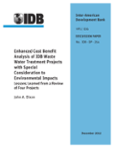Enhanced Cost Benefit Analysis of IDB Waste Water Treatment Projects with Special Consideration to Environmental Impacts: Lessons Learned from a Review of Four Projects
Date
Dec 2012
Development projects have a wider set of impacts than just direct project outputs. A hydropower dam, for example, produces electricity but also disrupts river flows and may affect biodiversity and the general aquatic environment. A new port development may affect coastal resources such as mangroves and coral reefs. Coal-fired power plants affect both the local and the global environments through emissions of ash and dust (affecting mostly the local environment) as well as greenhouse gases (affecting the global environment). Sewage and sanitation projects provide new services to consumers but also change the quantity and quality of wastewater released into the environment. An enhanced economic analysis allows this wider range of impacts -both benefits and costs- to be taken into account. This approach follows the IDB's operational directives (OP 703, Directives B.5 and B.9) and is explained in an IDB Technical Note IDB-TN-428 (Dixon, 2012). This paper builds upon existing analyses of four recent IDB projects to apply this approach. The projects selected for this study deal with the water sector and range in monetary value from US$9.5 million (Guyana) to US$246.5 million (Trinidad and Tobago), with Paraguay (US$20 million) and Uruguay (US$118.6 million) in between.



